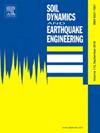A numerical method for evaluating the earthquake response of a 5 MW OC4 semi-submersible FOWT under multidirectional excitations
IF 4.2
2区 工程技术
Q1 ENGINEERING, GEOLOGICAL
引用次数: 0
Abstract
In this study, the earthquake behavior of the 5 MW OC4 semi-submersible floating offshore wind turbine (FOWT) under multidirectional earthquakes was analyzed using finite element computer program ABAQUS. Considering the lateral displacement of the superstructure, settlement, and bending moment of the tower and shear stress, a comparison between the earthquake behavior of the FOWT under the earthquake was performed. Firstly, the dynamic response of the structure was evaluated under the unidirectional and multidirectional excitation corresponding to the earthquake. The effects of vertical and horizontal earthquake components on the dynamic response of the FOWT are discussed separately. Then, the effects of different earthquake types, intensities and multidirectional earthquakes on the dynamic response of FOWT are investigated separately. Finally, the influence of the parameters such as the added mass, the drag force of the mooring and hydrodynamic pressure due to vertical earthquakes on the FOWT system was analyzed. The results show that the long period ground motion with concentrated energy can cause a large response, while the short-period ground motion with more dispersed energy can cause a relatively small response. Meanwhile, under the influence of vertical excitation, a significant acceleration amplification effect is generated at the nacelle.
多向激励下5mw OC4半潜式FOWT地震响应的数值计算方法
采用有限元软件ABAQUS,对5mw OC4半潜式浮式海上风电机组(FOWT)在多向地震作用下的地震行为进行了分析。考虑上部结构的侧向位移、沉降、塔的弯矩和剪应力等因素,对桥架在地震作用下的抗震性能进行了比较。首先,计算了结构在地震对应的单向和多向激励下的动力响应。分别讨论了竖向地震分量和水平地震分量对桥梁动力响应的影响。然后,分别研究了不同地震类型、烈度和多向地震对FOWT动力响应的影响。最后,分析了附加质量、系泊阻力和垂直地震作用下的动水压力等参数对系统的影响。结果表明,能量集中的长周期地震动会产生较大的响应,而能量较分散的短周期地震动会产生较小的响应。同时,在垂直激励的影响下,机舱处产生了明显的加速度放大效应。
本文章由计算机程序翻译,如有差异,请以英文原文为准。
求助全文
约1分钟内获得全文
求助全文
来源期刊

Soil Dynamics and Earthquake Engineering
工程技术-地球科学综合
CiteScore
7.50
自引率
15.00%
发文量
446
审稿时长
8 months
期刊介绍:
The journal aims to encourage and enhance the role of mechanics and other disciplines as they relate to earthquake engineering by providing opportunities for the publication of the work of applied mathematicians, engineers and other applied scientists involved in solving problems closely related to the field of earthquake engineering and geotechnical earthquake engineering.
Emphasis is placed on new concepts and techniques, but case histories will also be published if they enhance the presentation and understanding of new technical concepts.
 求助内容:
求助内容: 应助结果提醒方式:
应助结果提醒方式:


